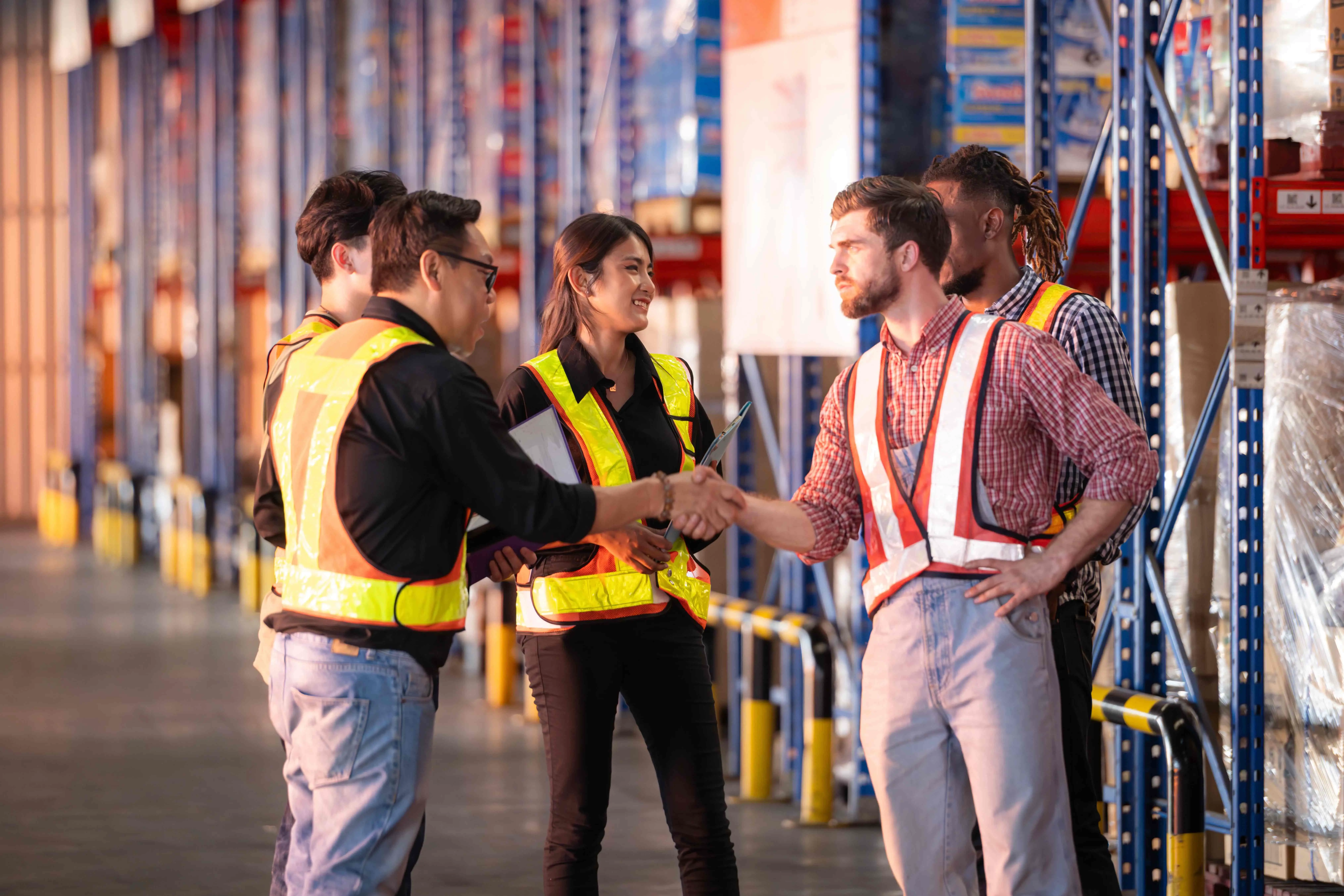How leading companies use AI in the supply chain

AI is reshaping supply chain operations, unlocking new levels of efficiency and innovation. Leading companies like Amazon, Walmart, and Maersk demonstrate its transformative potential. Amazon uses AI to optimize inventory and streamline warehouse operations. Walmart employs AI for demand forecasting, reducing stockouts and improving customer satisfaction. Maersk leverages AI for real-time shipment tracking and predictive risk management. AI also enhances supply chain resilience by automating processes and simulating scenarios to prepare for disruptions. Studies show AI-driven route optimization can cut fuel costs by 25% and improve on-time deliveries by 30%, proving its impact on global logistics.
The Role of AI in Modern Supply Chains

How AI is Revolutionizing Supply Chain Management
AI is transforming supply chain management by enhancing efficiency, safety, and inventory control. You can see its impact in areas like warehouse operations, where AI integrates with systems using technologies such as computer vision and digital twins. These tools improve quality control and streamline inventory processes. Advanced robotics powered by AI also play a significant role. They handle tasks like picking, packing, and shipping, reducing labor costs while boosting operational efficiency.
Many companies are already reaping the benefits of AI. Walmart uses AI to predict demand and optimize inventory, ensuring products are available when customers need them. DHL employs AI for route optimization, cutting delivery times and fuel consumption. Research shows that 37% of businesses, including those in supply chain management, have experienced measurable improvements from AI solutions. These examples highlight how AI is revolutionizing the way supply chains operate.
Key AI Technologies Driving Supply Chain Innovation
Several AI technologies are driving innovation in supply chains. AI-enabled visibility solutions use IoT sensors to provide real-time insights, helping you anticipate replenishment needs and ensure compliance. Demand forecasting tools analyze large datasets to predict customer needs accurately. For example, American Tire Distributors uses AI for dynamic planning, improving their supply chain efficiency. Inventory management systems powered by AI optimize stock levels, as seen with Gaviota, which significantly reduced its inventory costs.
Dr. Michael Schrage from MIT Sloan School of Management emphasizes that AI fundamentally changes supply chain operations. It enables more accurate forecasting and better inventory management, ensuring businesses stay ahead in a competitive market.
The Importance of Data in AI-Driven Supply Chains
Data is the backbone of AI in supply chains. Timely and intelligent decision-making relies on accurate data. AI leverages this data to anticipate future needs across the supply chain, improving efficiency and reducing risks. For example, real-time monitoring enhances visibility, allowing you to track supply networks and respond quickly to disruptions.
However, many companies struggle with limited visibility. Only 2% of businesses have insight beyond their second-tier suppliers, leaving them vulnerable to risks. AI bridges this gap by providing a single source of truth, improving customer experiences and ensuring seamless operations. With AI, you can achieve an end-to-end supply chain transformation, making your processes more resilient and efficient.
How Leading Companies Leverage AI in the Supply Chain
AI-Powered Demand Forecasting
AI-powered demand forecasting has become a cornerstone for leading companies aiming to optimize their supply chain operations. By leveraging AI, businesses can predict customer needs with precision, ensuring products are available when and where they are needed. Amazon exemplifies this approach by using AI to monitor competitor pricing and automate warehousing processes. This enables accurate forecasting and efficient inventory management, reducing the risk of overstocking or stockouts.
JusLink, JUSDA’s intelligent supply chain platform, takes demand forecasting to the next level. It uses deep learning algorithms to analyze market trends and predict demand patterns. This allows you to dynamically adjust inventory levels, ensuring optimal stock availability. JusLink’s AI-driven forecasting tools empower businesses to make data-backed decisions, enhancing supply chain efficiency and reducing costs. Other leading companies like Zara and Walmart also utilize AI to refine demand forecasting, demonstrating its transformative impact across industries.
Route Optimization and Delivery Efficiency
AI has revolutionized route optimization, enabling companies to streamline delivery operations and improve customer satisfaction. Walmart, for instance, employs AI-enabled delivery systems to plan efficient routes, reducing operational costs and ensuring timely deliveries. AI systems analyze real-time data, such as traffic conditions and delivery windows, to dynamically adjust routes. This adaptability minimizes disruptions and enhances last-mile delivery efficiency.
AI-powered route optimization offers significant benefits. It reduces fuel costs by up to 25% and increases on-time deliveries by 30%. These systems can manage thousands of delivery routes while considering constraints like vehicle types and traffic patterns. By integrating AI into your delivery operations, you can achieve faster, more reliable supply chain performance.
Warehouse Automation and Robotics
Warehouse automation is another area where AI is making a profound impact. Leading companies like Amazon use AI-powered robotics in their fulfillment centers to handle tasks such as picking, packing, and inventory management. These robots work alongside human employees, improving efficiency and reducing labor costs. AI also processes large datasets to optimize warehouse layouts and allocate labor effectively.
Collaborative robots, or “cobots,” are reshaping warehouse operations by focusing on flexibility and human-robot collaboration. For example, UPS uses AI to batch orders, reducing travel time for pickers and improving accuracy. As AI continues to advance, robots are expected to take on more complex tasks, further enhancing warehouse automation and supply chain efficiency.
Risk Management and Disruption Mitigation
AI plays a pivotal role in managing risks and mitigating disruptions in the supply chain. Companies like Maersk demonstrate how AI enhances resilience by enabling real-time monitoring and predictive analysis.
Example: Maersk’s use of AI for supply chain resilience
Maersk uses AI to strengthen its supply chain resilience by detecting potential risks early. For instance, AI systems monitor shipping routes and identify disruptions such as port congestion or adverse weather conditions. This allows Maersk to reroute shipments proactively, minimizing delays. Predictive analytics also help the company anticipate raw material shortages and adjust procurement strategies accordingly. These capabilities ensure smoother operations and reduce the impact of unforeseen events.
Other companies, including Walmart and Unilever, also leverage AI to prepare for disruptions. AI technologies have become essential in adapting to challenges like those experienced during the Covid-19 pandemic. By analyzing vast amounts of data, AI enables businesses to design effective solutions and deploy them swiftly.
JusLink’s intelligent risk management capabilities
JusLink, JUSDA’s intelligent supply chain platform, takes risk management to the next level. Its Control Tower Intelligent Risk Management system integrates external data to monitor risks in real time. This feature identifies potential issues, such as shipping delays or inventory shortages, and provides immediate alerts. You can use these insights to create contingency plans and respond quickly to disruptions.
JusLink also employs generative AI to propose innovative risk mitigation strategies. For example, it can suggest alternative suppliers or routes to reduce dependency on critical supply chain nodes. The platform’s intuitive interface makes it easy to analyze risks and share insights with your team. By leveraging JusLink, you gain comprehensive control over your supply chain, ensuring resilience and efficiency.
AI-driven risk management tools like JusLink empower businesses to stay ahead of challenges. They enhance visibility, improve decision-making, and minimize the impact of disruptions, making your supply chain more robust and reliable.

JUSDA Solutions
To provide you with professional solutions and quotations.
Benefits of AI in the Supply Chain
Cost Reduction and Operational Efficiency
AI transforms supply chain operations by reducing costs and improving efficiency. It streamlines logistics through real-time visibility, better demand forecasts, and optimized inventory levels. These improvements lower carrying costs and minimize the risk of stockouts. For example, AI-driven route optimization increases delivery capacity without requiring additional resources. This directly boosts revenue while cutting operational expenses.
You can also benefit from AI's ability to enhance productivity and agility. It saves time by automating repetitive tasks and improves skills retention by enabling employees to focus on strategic activities. AI-powered systems ensure your supply chain operates smoothly, delivering measurable benefits like cost savings and better customer experiences.
Tip: By integrating AI into your supply chain, you can achieve significant time savings and operational agility, making your processes more competitive.
Enhanced Customer Service and Experience
AI enhances customer service by providing real-time insights and proactive solutions. Companies like Maersk and Walmart use AI to track shipments and predict potential delays. This allows them to notify customers in advance, ensuring transparency and trust. AI-powered systems also improve response times, offering immediate support through chatbots and automated tools.
Benefit | Description |
|---|---|
24/7 Availability | GenAI chatbots provide round-the-clock customer support. |
Faster Response Times | Immediate responses enhance the overall customer experience. |
Consistency | AI-driven responses ensure consistent and accurate information delivery. |
Cost Efficiency | Automating customer support reduces the need for large teams, lowering costs. |
Scalability | GenAI systems can handle increasing volumes of inquiries without compromising quality. |
By leveraging AI, you can deliver faster, more reliable service, improving customer satisfaction and loyalty.
Real-Time Decision-Making with Data Insights
AI empowers you to make informed decisions by analyzing data in real time. It continuously processes inputs to identify trends, forecast demand, and optimize inventory levels. For instance, AI can predict raw material shortages years in advance, helping you avoid production bottlenecks. It also assists in scheduling maintenance and preventing equipment failures, ensuring uninterrupted operations.
AI tools like Loadsmart's CoPilot use generative AI to create detailed reports and visualizations. These tools provide actionable insights, enabling you to respond quickly to changes in the supply chain. With AI, you gain the ability to adapt to challenges and seize opportunities with confidence.
Note: Real-time insights from AI give you a competitive edge by improving planning and decision-making across your supply chain.
Improved Inventory Management and Demand Forecasting
AI has revolutionized inventory management and demand forecasting, enabling businesses to operate with greater precision and efficiency. By analyzing extensive datasets, including historical sales and market trends, AI-driven systems provide accurate predictions. These insights allow you to maintain optimized inventory levels, reducing waste and ensuring products are available when needed.
AI automates the demand forecasting process, saving time and improving accuracy. Instead of relying on manual data analysis, you can use AI to predict customer needs and adjust inventory planning dynamically. This automation minimizes the risk of overstocking or stockouts, which often disrupt supply chain operations. For example, AI models adapt to seasonal variations, helping you align production and inventory with changing demand patterns.
With AI, you gain the ability to respond quickly to market fluctuations. Real-time data analysis ensures that your supply chain remains agile and resilient. AI tools continuously learn and refine their predictions, allowing you to stay ahead of trends and make informed decisions. This adaptability enhances operational efficiency and reduces costs across the supply chain.
JusLink, JUSDA’s intelligent supply chain platform, exemplifies how AI can transform inventory management. Its AI-driven forecasting tools analyze market trends and customer behavior, enabling you to plan inventory with precision. By leveraging JusLink, you can achieve optimized inventory levels and improve overall supply chain performance.
Incorporating AI into your supply chain operations ensures better inventory management and demand forecasting. These advancements not only enhance efficiency but also strengthen your ability to meet customer expectations, giving you a competitive edge in today’s dynamic market.
Challenges and Limitations of AI in Supply Chain Management
Data Quality and Integration Issues
AI relies heavily on accurate and accessible data to function effectively. However, many supply chains face challenges in ensuring data quality and availability. You may encounter issues such as data inaccessibility, where critical information is not readily available for AI systems. Functional silos within organizations can also limit data sharing, reducing the effectiveness of AI-driven solutions.
Legacy systems often pose another hurdle. These outdated technologies make integration with existing systems difficult and require significant resources to update. Additionally, the diversity of data sources in supply chains adds complexity. Managing varied formats and origins is essential but challenging. Poor data quality further undermines AI performance, leading to inaccurate predictions and inefficiencies. Addressing these issues is crucial for successful AI adoption in supply chain operations.
High Costs of AI Implementation
Implementing AI in your supply chain can involve substantial financial investment. The costs include acquiring advanced technologies, training employees, and maintaining AI systems. Despite these expenses, the benefits often outweigh the initial costs. According to McKinsey & Company, companies that adopt AI can reduce logistics costs by 15%, improve inventory levels by 35%, and enhance service levels by 65%.
AI also optimizes demand forecasting, inventory management, and delivery routes. These improvements lead to cost savings and better customer satisfaction. While the upfront investment may seem high, the long-term financial gains make AI a valuable addition to your supply chain strategy.
Ethical and Privacy Concerns in AI Applications
AI introduces ethical and privacy challenges in supply chain management. When AI handles sensitive data, privacy concerns arise. The opacity of AI decision-making processes can also create trust and accountability issues. To address these concerns, you should prioritize transparency and fairness in AI applications.
Conducting bias audits through third-party evaluators ensures ethical AI use. Implementing explainable AI models helps build trust by making decision-making processes clear. Human oversight remains essential for interpreting AI outputs and maintaining accountability. By addressing these ethical and privacy concerns, you can ensure responsible AI integration in your supply chain.
Overcoming Legacy System Barriers
Legacy systems often hinder the adoption of AI in supply chains. These outdated systems lack the flexibility and scalability needed to support modern technologies. Overcoming these barriers requires strategic planning and practical solutions.
To begin, you can integrate AI with existing systems without disrupting operations. This approach ensures a smooth transition while maintaining business continuity. Allocating funds effectively is also essential. High maintenance costs of legacy systems can strain budgets, so careful financial planning helps balance ongoing operations with new technology investments. Enhancing flexibility is another critical step. Legacy systems often operate rigidly, making it harder to adapt to changing demands. By addressing this rigidity, you can create a more adaptable and efficient supply chain. Finally, managing data effectively is crucial. Organizing data in a way that works for both old and new systems ensures seamless operations.
Here are some strategies you can use to overcome these challenges:
Strategy | Description |
|---|---|
APIs and Middleware | Use APIs and middleware to connect legacy systems with AI platforms for better integration. |
Incremental Modernization | Upgrade critical parts of legacy systems gradually to incorporate AI capabilities. |
Cloud Migration | Move legacy systems to the cloud for easier integration with AI tools and improved scalability. |
These strategies provide practical ways to modernize your supply chain. APIs and middleware act as bridges, enabling legacy systems to communicate with AI platforms. Incremental modernization allows you to upgrade systems step by step, reducing risks and costs. Cloud migration offers scalability and simplifies the integration of AI tools.
By adopting these methods, you can overcome the limitations of legacy systems. This ensures your supply chain remains competitive and ready for the future.
Future Trends and Opportunities in AI for Supply Chains

Generative AI and Its Potential in Supply Chain Innovation
Generative AI is transforming how you approach supply chain innovation. It offers tools that enhance efficiency and decision-making across the entire supply chain. For example, you can use AI to predict demand and optimize inventory, avoiding stockouts and overstocking. Generative AI also improves logistics by creating real-time delivery routes based on traffic and weather conditions. This ensures faster and more reliable deliveries.
You can also rely on AI to analyze supplier performance and recommend the best partners. It identifies alternatives when disruptions occur, strengthening your supply chain resilience. Additionally, AI optimizes production schedules and workflows, helping you achieve higher efficiency in manufacturing. By reducing waste and resource usage, generative AI supports sustainability goals, making your supply chain greener and more cost-effective.
AI-Driven Sustainability and Green Supply Chains
AI plays a critical role in building sustainable supply chains. It helps you reduce waste, lower emissions, and improve resource efficiency. Predictive demand forecasting ensures you source materials efficiently, minimizing excess inventory. AI also determines optimal transportation routes, reducing fuel consumption and carbon emissions.
Application | Description |
|---|---|
Predictive Demand Forecasting | AI analyzes data to predict future demand, optimizing sourcing and reducing waste. |
Intelligent Routing and Logistics | AI determines efficient transportation routes, minimizing fuel usage and emissions. |
Supply Chain Transparency | AI and blockchain track materials, ensuring sustainable and ethical sourcing. |
Carbon Footprint Reduction | AI identifies opportunities for reducing carbon footprints, supporting sustainability goals. |
Eco-friendly Supplier Selection | AI aids in selecting suppliers that are environmentally friendly, enhancing brand image. |
By integrating AI into your supply chain, you can achieve sustainability while maintaining efficiency. These advancements not only benefit the environment but also enhance your brand reputation.
Autonomous Supply Chain Systems
Autonomous supply chain systems represent the future of logistics and manufacturing. These systems use AI to automate processes, reduce costs, and improve efficiency. For example, AI-driven procurement tools select suppliers and negotiate terms based on predicted demand. In manufacturing, smart factories use robotics to speed up production and enhance quality.
Feature | Description |
|---|---|
Procurement | AI-driven systems can automate supplier selection and negotiate terms based on predicted demand. |
Production | Smart factories utilize AI and robotics to enhance manufacturing processes and speed. |
Warehousing | Robotic systems manage inventory and packaging in automated warehouses powered by AI. |
Distribution and Delivery | Autonomous vehicles and drones ensure efficient deliveries with intelligent route planning. |
Sustainability | AI optimizes routes and inventory to reduce waste and energy consumption. |
Autonomous systems also improve scalability and agility. They adapt quickly to disruptions, ensuring your supply chain remains resilient. By adopting these technologies, you can achieve an end-to-end supply chain transformation, making your operations faster, smarter, and more reliable.
The Role of Platforms like JusLink in Shaping the Future of Supply Chains
Platforms like JusLink are transforming how you manage supply chains by integrating advanced technologies. JusLink, powered by AI, offers tools that enhance efficiency, accuracy, and decision-making. It provides solutions tailored to meet the demands of modern supply chains, ensuring you stay competitive in a rapidly evolving market.
JusLink excels in areas like smart forecasting and replenishment. For example, it helped a global industrial company improve supply chain performance by enhancing forecasting accuracy by 78%. This improvement significantly boosted inventory turnover, ensuring better resource utilization. With such capabilities, JusLink empowers you to predict demand and adjust inventory dynamically, reducing waste and improving operational efficiency.
The platform also strengthens supply chain resilience. Its intelligent risk management system monitors potential disruptions in real time. By analyzing external data, JusLink identifies risks like shipping delays or inventory shortages and alerts you immediately. This allows you to act quickly and maintain smooth operations. Additionally, JusLink’s generative AI capabilities suggest alternative suppliers or routes, ensuring your supply chain remains robust even during unexpected challenges.
JusLink’s microservices architecture offers flexibility. You can customize its features to suit your specific business needs. This adaptability ensures seamless integration into your existing systems, making it easier to modernize your supply chain without disrupting operations. By leveraging JusLink, you gain end-to-end visibility and control, enabling you to make informed decisions and optimize performance.
Platforms like JusLink are shaping the future of supply chains by combining AI-driven tools with innovative features. They help you achieve greater efficiency, reduce risks, and adapt to changing market conditions. With JusLink, you can transform your supply chain into a smarter, more resilient system.
Leading companies are revolutionizing supply chains with AI, achieving remarkable efficiency and adaptability. AI-powered tools automate processes, optimize inventory, and enhance demand forecasting, as seen with Amazon and Walmart. These advancements reduce costs, improve resource allocation, and ensure timely deliveries. To integrate AI into your supply chain, start by defining clear goals and collecting relevant data. Choose AI technologies that align with your objectives, and pilot small projects to measure effectiveness. Platforms like JusLink simplify this process, offering intelligent solutions to enhance efficiency and resilience. Embracing AI ensures your supply chain remains competitive and future-ready.
See Also
Exploring AI's Role in Shaping Future Supply Chains
Enhancing Supply Chain Efficiency Through AI Innovations
Transforming Logistics for Tomorrow with AI Supply Chains
